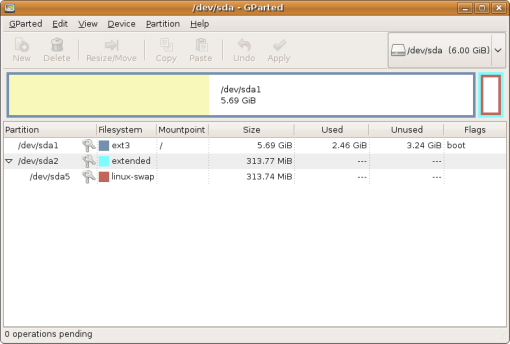GParted is one of the most well known GUI tools in the Linux world and the most popular partition managing tool on Linux as well. It’s a free and open-source utility like every other widely used Linux app out there. GParted is written in C++ and being a tool with a GUI, it’s rather easy to use for anyone. The app can be installed on most popular Linux distros including Ubuntu, Fedora, Arch Linux, and their derivatives. It’s available to download on the distro’s software center and from its official website. Like most partition managers, GParted can help you create and resize unmounted partitions only.
So if you’ve installed GParted on your Linux distro, you can’t work with the partition your Linux system is installed on. So to do that, you’ll need the Live USB version of GParted. Apart from that, the Live USB version or the installable versions are very much the same things.
GParted basics
- Launch GParted and enter the root password (your password, in most cases) when asked. It will take a few seconds to load up all the necessary information about the mounted or unmounted disks and partitions.
- Select the disk you want to partition from the drop-down menu in the top-right.
- If you see a lock icon next to a hard-disk partition, it means that partition is currently mounted and cannot be resized, deleted, or anything else. To unmount it, just right-click on it and select Unmount. The lock should then disappear allowing you to modify the partition. If you see an error like “Couldn’t unmount..target is busy”, it might be because it’s a live partition that your OS is installed on. This won’t be a problem with a Live USB.
‘gparted’ is the graphical version of ‘parted’ and is the tool to use to resize the main partition used for raspbian (or you could use use parted if you prefer the command line of course!). It can also be used to check and repair a SD card disk. GParted (FNOME partition Editor) is a piece of partition managing software. It can be used to create, delete, resize, copy partition, convert MBR to GPT disk or GPT to MBR disk, and recover deleted partition, and so on.
You may also like: How to Backup and Restore Linux Using Timeshift
Create and Resize Partitions with GParted
Linux Partition Manager Windows
- You can now Delete a partition to create a new one in another format or you can resize the partition. While resizing is relatively safer, you’ll have to make sure you don’t resize enough to delete the data stored. For instance, if you have 4GB of data on a partition, you should probably keep its size well over 4GB. To resize, Right-click on it and select Resize/Move.
- GParted lets you drag and resize partitions as well as input the exact size from the keyboard.
- As you can see in the screenshot below, you can enter any values in the text fields labeled Free space preceding or Free space following. It is generally easier and safer to resize a partition from the tail end, that is from the right (Free space following). When you’re ready, click on the Resize/Move button.
- You’ll now have an Unallocated partition. It cannot be used until you allocate a file system. This can also be done with a right-click. Select New from the context menu and then enter a size for the partition if you still want to save some space for another partition. You can leave the default size as it is if you intend to use the entire space for the partition. Select a filesystem of your choice and give it a label (optional). Click Add when you’re ready.
Apply changes
Everything you do in GParted is only a preview. Nothing you did matters yet and it won’t until you apply those changes. Click on the Apply button at the top to apply the changes you’ve made. Click Close when the changes are applied and you’re done.
Read on: 5 Popular Mac and Windows Apps Also Available For Linux
Install Gparted Partition Manager in Ubuntu via terminal and Ubuntu Software Center

Gparted For Windows
Gparted a free open source software for graphically managing the hard disks. With live Gparted on a bootable pen drive you can copy, label, resize and move partition without loss of data. It can also rescue data from lost partitions. Gparted can work with or create ext2, ext3, ext4, fat16, fat32, hfs, hfs+, linux-swap, lvm2 pv, nilfs2, ntfs, reiserfs, reiser4,ufs and xfs formats.
Gparted is the one of the best hard disk management software for Ubuntu and Linux Base Derivatives. There is two method to use it. You can install it on the system or can create a bootable pen drive with the ISO file of the Gparted.
installation of Gparted in a Ubuntu-Debian system
- 1. Via Terminal
- 2. Via Ubuntu Software Manager
Yumi
1. Via Terminal
Open the terminal via “Ctrl+Alt+T” and run the command below.
2. Via Ubuntu Software Manager
Open the Ubuntu Software Manager and search Gparted. It will search the Gparted. Now click “Install” to install the Gparted.
Creating a Live Bootable Pen Drive with Gparted ISO
First download Gparted ISO from the link below

Now read the posts to create the gparted bootable pen drive in windows and linux via clicking the link below
Comments are closed.